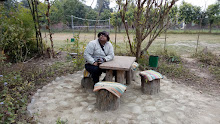Parthenium hysterophorus
BOTANICAL NAME: Parthenium hysterophorus
FAMILY: Asteraceae (Sunflower family)
COMMON NAME: Carrot Grass, Congress grass, Wild carrot weed Hindi: gajar ghas, Chatak Chandani
DISTRIBUTION:
Carrot Grass is native to the subtropics of North and South America.
It is considered a highly invasive weed. Its large and persistent soil seedbank, fast germination rate and ability to undergo dormancy make it well adapted to semi-arid environments.
P. hysterophorus invades all disturbed land, including farms pastures, and roadsides. In some areas, outbreaks have been of almo. In India, it is locally known as Congress Grass or Gajar Ghans. It was first present as a contaminant in imported wheat. It can trigger allergies and is a common cause of pollen allergy.
BOTANICAL DESCRIPTION :
# Young plants form a basal rosette of strongly dissected leaves that are up to 30cm in length. Once stem elongation is initiated, smaller leaves are produced and the plant becomes much-branched in its extremities.
# It is a fast-maturing annual (or, under certain conditions, a short-lived perennial) with a deep tap root and an erect stem that becomes woody with age.
# It may eventually reach a height of 2 m.
# Its leaves are pale green, branched and covered with soft fine hairs.
# The small white flowers (4 mm across) have five distinct corners and grow on the stem tips. Each flower produces 4-5 black wedgeshaped seeds that are 2 mm long with thin white scales. It also releases chemicals that inhibit the germination and growth of pasture grasses and other plants.
SEXUAL REPRODUCTION :Highly prolific. An average plant can produce 15,000 seeds and large plants are known to produce 100,000 seeds.
LIFE-CYCLE STAGES :
Germination temperatures for Parthenium occur across the 8 to 30° C range with the optimum germination temperature being 22 to 25° C. Persistence tests demonstrated that more than 70% of parthenium seeds buried at 5cm below the soil surface survived for at least 2 years whereas surface-lying seeds survived for no longer than 6 months. Parthenium weed seeds were found to be very persistent in the soil and there was relatively little change in their abundance over an 18 month period. The germination rate of parthenium weed seeds was also significantly faster than that of all other species present (Sheldon Navie, 2003).
GENERAL IMPACT :
Infestations of parthenium weed can degrade natural ecosystems. The plant can produce serious allergenic reactions in humans. Parthenium aggressively colonises disturbed sites and has major impacts on pasture and cropping industries, spreading to and impacting on new areas.
Outcompetes native species, in part due to allelopathy.
Contact with this plant causes dermatitis and respiratory malfunction in humans, dermatitis in cattle and domestic animals, due to the presence of toxin parthenin
MANAGEMENT INFORMATION:
Control of parthenium weed can be managed using a combination of methods depending on the site, including biological control agents, pasture management, cultivation and chemicals.
Preventative measures: Emphasis must be laid on establishing detection/monitoring procedures and stopping the spread of parthenium weed via vehicles and as a contaminant. A Risk assessment of Parthenium hysterophorus for Australia was prepared by Pacific Island Ecosystems at Risk (PIER) using the Australian risk assessment system (Pheloung, 1995). The result is a score of 18 and a recommendation of: reject the plant for import (Australia) or species likely to be a pest (Pacific).
The Parthenium weed management book provides information on management and control aspects including spread minimization, pasture management, herbicide use, biological control and health aspects. It also describes the parthenium weed and provides basic information about its ecology and biology, reproduction and spread, current distribution, and potential threat. The Weed Control Methods Handbook provides you with detailed information about the tools and techniques available for controlling invasive plants, or weeds, in natural areas. This Handbook is divided into eight chapters, covering a range of different control methods: manual, mechanical, promoting competition from native plants, grazing, biocontrol, herbicides, prescribed fire, solarization, flooding, and other, more novel, techniques. Each control method has advantages and disadvantages in terms of its effects against the target weed(s), impacts to untargeted plants and animals, risks to human health and safety, and costs.
Biological: Biological control using insects and fungi is being pursued in Australia and in India.
SOURCES:
>>http://
>>http://
>>http://en.wikipedia.org/
>>http://www.issg.org/
>>http://

%5D+ban+tulsi.JPG)










0 comments:
Post a Comment